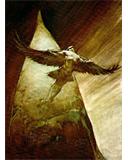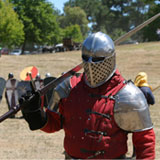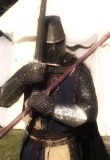 |
|
|
|
| Author |
Message |
John
Location: Wellington
|
 Posted: Mon Aug 22, 2011 9:36 pm Distance and measure. Posted: Mon Aug 22, 2011 9:36 pm Distance and measure. |
 |
|
| Distance and measure I have a few questions about this.Is distance the actual distance between you and your opponent and could you say that measure is the tempo at which you fight or have I got at completely wrong.Help please. |
|
|
 |
Mad Jim

Location: Dunedin
|
 Posted: Mon Aug 22, 2011 9:40 pm Posted: Mon Aug 22, 2011 9:40 pm |
 |
|
Sounds about right. But then again Distance could be Measure, as I guess you could use measure to get the correct distance.... Should check http://www.swordsmanship.co.nz/forums/ they would give a much better explaination..
_________________
I like living.. |
|
|
 |
Freebooter
Principal Sponsor

Location: Hamilton
|
 Posted: Mon Aug 22, 2011 10:57 pm Posted: Mon Aug 22, 2011 10:57 pm |
 |
|
Distance and Measure are the same.
Tempo is your time.
Timing is what happens when two tempi meet.
Nic |
|
|
 |
Patch

Location: Auckland
|
|
|
 |
Colin

Location: Wellington
|
 Posted: Tue Aug 23, 2011 9:03 am Posted: Tue Aug 23, 2011 9:03 am |
 |
|
As far as fencing theory goes, you need to understand how Aristotle used them, and how fencing masters adapted Aristotle to their practices.
Measure is a subset of distance. Distance is any line between points A and B; so distance could be curved, bent or straight. Measure refers only to the straight line between A and B, i.e. "as the crow flies" or the "short cut" (sorry, I had to pun).
In the measures (misura) are your fighting "distances". Outside the measures time or tempo does not exist. So, yes, you are correct when you say "...measure is the tempo at which you fight...".
This is only a brief outline of what the measures are.
I would not use the link Eamon refers to. Their opening paragraph is okay, but they really demonstrate their lack of knowledge in their second paragraph with
"The closest measure is when you can extend your hand and grasp the opponent’s hilt or body. This is the measure in which dagger fights, or hand to hand occur. It can be referred to as Close Measure."
The first sentence is fine. The second sentence is horrendous. Weapon length (or lack thereof) does not determine measure. The rest of the webpage does not get any better.
_________________
The person who writes for fools is always sure of a large audience.
- Arthur Schopenhauer
See http://www.swordsmanship.co.nz/ |
|
|
 |
Freebooter
Principal Sponsor

Location: Hamilton
|
 Posted: Wed Aug 24, 2011 10:11 pm Posted: Wed Aug 24, 2011 10:11 pm |
 |
|
Hi Folks,
The discussion caught my interest.

Some Quotes - from the bits of history when they figured this stuff out...
From Marozzo, (1536)
| Quote: | "The practical principles of playing and honor I give to you for your comfort so you do not make such a mystery of this art: for this is of great danger.
"If your enemy throws a fendente, roverso, stramazzone or thrust at the face I want you in the same time to strike at the attack
with the false edge of your sword and slice his face with a filo dritto traversato.
"Then if your enemy attacks your head or your leg immediately hurl your left foot opposite your right side and
put a falso under that of your enemy’s sword stepping in this time with your right foot strongly to the left side of the same. |
NOTE SYNTAX - IN THE SAME TIME, not AT THE SAME TIME.
Marozzo defines stezzo, mezzo and due tempi attacks (single, half and double). All refer to the action performed by a single fighter, not the relationship between two fighters.
These are referred as the time taken to perform the action. Di Grassi improved this logic further....
From Di Grassi (1570, english 1594) on the governors of the fight.
| Quote: | "That the right or straight line is of all others the shortest: wherefore if a man would strike in the shortest line, it is requisite that he strike in the straight line.
"Secondly, he that is nearest, hits soonest. Out of which advertisement a man may reap this profit; that seeing the enemies sword far off, aloft and ready to strike, he may first strike the enemy, before he himself is struck.
"Thirdly, that the compass of a circle bears more force in the extremity of the circumference than in the center therof
"Fourthly, that a man may more easily withstand a smaller than a greater force
"FIFTHLY, THAT EVERY MOTION IS ACCOMPLISHED IN TIME.
"Il quinto che ogni moto e fatto in tempo"
"That by these rules a man may get judgement, it is most clear, seeing there is no other thing required in this art than to strike with advantage and defend with safety.
"This is done when one strikes in the right line, by giving a thrust or by delivering an edge-blow with that place of the sword where it carrieth most force, first striking the enemy before [one] be stricken: the which is performed, when he perceives himself to be nearer his enemy. In which case, he may nimbly deliver it. For there are few, nay there is no man at all, who, (perceiving himself to be stricken) goes not back and forsakes to perform every other motion which he has begun.
"And in as much as he knows that every motion is made in time, he endures himself to strike and defend, that he may use as few motions as is possible and therin to spend as little time; and as his enemy moves much in diverse times he may be advertised hereby, so strike him in one or more of those times, ... Out of all due time taken.
|
Pardon my quoting the piece entire, but I happen to like Di Grassi. He makes some very good points. I like the one about every action happening in it's own time. It's the first real definition of Tempo. Or time, if you prefer.
Fabris 1606
| Quote: | | “We call tempo every motion made by the opponent while in measure. A motion he makes while out of measure is merely a motion or change of posture; because in this art, tempo must represent an opportunity to strike the opponent or at least to gain an advantage over him.” |
Fabris also defines measure much as Colin has, the distance at which a blow may be struck.
So Colin's bang on, as far as Fabris is concerned.
Sir Willaim Hope (1687)
| Quote: | | "Measure is the distance betwixt a Man and his Adversary, which should be exactly observed, that when he is Thrusting at you, You may be without his Measure or Reach, ... and that when you are Thrusting at him, that your thrust may be home, and not short of him when you are at your Elonge (Lunge). ... [This] is called the Measure betwixt the two [Fighters]. |
| Quote: | | To take time is either never to thrust, but when you have a fit opportunity, or otherwise it is the thrustig at your Adversarie just as he is making a fient, ot the flipping of him and giving him the thrust when he is either going to bind, or beat your sword. |
Here's a nice definition from Hope...
| Quote: | | "Contre-Temps is when a man thrusts without having a good opportunity, or when he thrusts at the same time his Adversairie thrusts, and that each of them at that time receive a thrust. |
"Irish", anyone?
Angelo (Sr) 1787
| Quote: | | To get within distance, is called advancing on your adversary, when he is at too great a distance from the point of your sword; to be without distance, is to retire when your adversary's point is too near. |
He follows this epistle with detailed instructions on how to do these things. Other than a constant requirement to use distance and time, Angelo doesn't mention it again.
He doesn't directly mention time or tempo at all. It's all inherit as far as Mr Angelo is concerned.
That about wraps it.
My point is, the definitions were being written throughout the historical period, We've got to look at them in terms of their evolution, and what it meant to the masters and students whose work we are attempting to recreate. We can't blaze in with modern interpretations and shoehorn them into place, because that way doesn't yeild good results.
So, for me the few lines I said above work. I feel they're a good consensus of historical thought. I'll also freely agree that they aren't perfect, but in terms of being useful and helpful in a fight, they've not failed me yet.
Nic |
|
|
 |
John
Location: Wellington
|
 Posted: Sun Sep 04, 2011 11:41 am Posted: Sun Sep 04, 2011 11:41 am |
 |
|
| Thank you all for your answers very informative. |
|
|
 |
|
|
 Please read the terms of use
Please read the terms of use
 Contact the Site Admin
Contact the Site Admin

